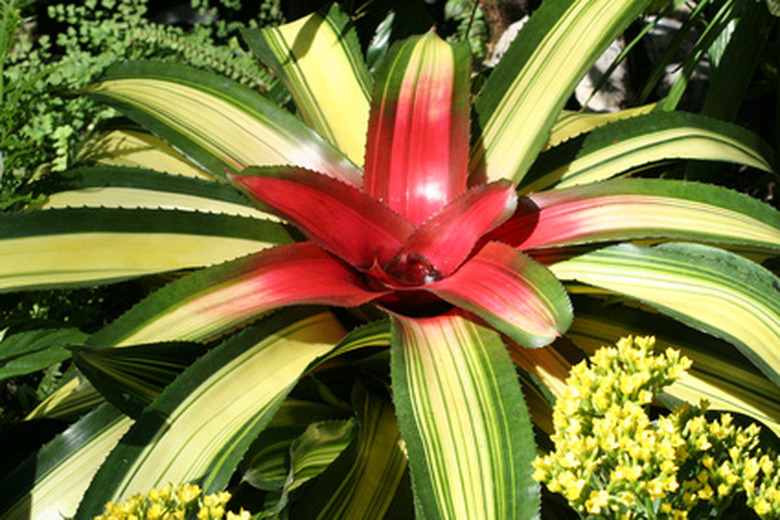Divisions Of The Plant Kingdom
Depending on which classification system you are using, the plant kingdom has anywhere from ten to 14 divisions. Divisions of plants are equal in taxonomic rank to phyla in the animal kingdom; in other words, phyla are below kingdom and above class in a hierarchical structure. Plants are separated into divisions based on a variety of characteristics, including the presence or absence of vascular tissue, whether they make seeds or are seedless, and, if they make seeds, whether the seeds are protected within a fruit.
12 Plant Divisions
12 Plant Divisions
The University of California Museum of Paleontology uses a system of 12 plant phyla, or plant divisions. There are living examples of seven of the 12 divisions: Anthocerotophyta (hornworts), Bryophyta (mosses), Hepaticophyta (liverworts), Lycophyta (club mosses and scale trees), Pteridopsida (ferns), Spermatophyta (seed plants) and Sphenopsida (horsetails).
Five of the 12 divisions are known only as fossils. Cladoxylopsida, Progymnosperms, Rhyniophytes, Trimerophytes and Zosterophylls are divisions of extinct plants, some of which are ancestors of plants that are living on Earth today.
Though some members of the plant kingdom are known to humans only through the fossil record, many played important roles in the evolution of the plant species that are alive today. According to Warner Pacific University, there are more than 295,000 species of plants, and many of these species evolved from common ancestors.
Vascular and Nonvascular Plants
Vascular and Nonvascular Plants
Taxonomists group plants into divisions by first considering whether the species is vascular or nonvascular. Vascular plants have specialized tissues used for conducting water, minerals and nutrients throughout the plant. Nonvascular plants, such as mosses, do not have these specialized tissues, but instead live in moist environments to ensure that they can absorb enough water to survive without a root system.
If the plant does not have xylem or phloem (vascular tissues) for transporting water and nutrients, it belongs to one of three divisions: the mosses, hornworts or liverworts. Another characteristic of nonvascular plants is that they do not have true leaves, stems or roots. However, these simple plants played an important role in the evolutionary development of land plants, as scientists believe that vascular plants evolved from nonvascular plants.
On the vascular side of the plant kingdom, the divisions of vascular plants include the club mosses and scale trees, ferns, horsetails and seed plants. Whether the plant uses seeds for reproduction is the next factor used to determine which division a plant species belongs to. Club mosses and scale trees, ferns and horsetails are vascular species that do not make seeds, but most have true leaves, stems and roots. Vascular plants that make seeds belong to the division of spermatophytes.
Seed Plant Classification
Seed Plant Classification
Next, the division of vascular plants that uses seeds for reproduction – the spermatophytes, or seed plants – are further classified based on whether they make fruits to protect their seeds. Gymnosperms make seeds but do not produce fruits, while angiosperms do produce fruits. The term gymnosperm comes from the Greek for "naked seed," and examples from this group include the conifers, ginkgos and palms.
Flower classification is also used to distinguish the angiosperms, as species in this group are known as the "flowering plants." Many of the plants that you are most familiar with – which are grown for food production or ornamental value – belong to this large and important part of the plant kingdom.
There are more than 200,000 species of angiosperms, and they are divided into two classes: monocots and dicots. Monocot seeds have one cotyledon, or embryonic leaf, while there are two cotyledons in dicot seeds. Examples of monocots include corn, grasses and irises. Many tree species, along with ornamentals like sunflowers, roses and food-producing plants like beans, are dicots.
A simple study of plant taxonomy and the 12 plant phyla is an eye-opening experience, revealing a great diversity of plant kingdom examples and an incredible story of evolution that spans millions of years and thousands of species.
Cite This Article
MLA
Sloane, Christina. "Divisions Of The Plant Kingdom" sciencing.com, https://www.sciencing.com/divisions-of-the-plant-kingdom-13428213/. 30 September 2021.
APA
Sloane, Christina. (2021, September 30). Divisions Of The Plant Kingdom. sciencing.com. Retrieved from https://www.sciencing.com/divisions-of-the-plant-kingdom-13428213/
Chicago
Sloane, Christina. Divisions Of The Plant Kingdom last modified March 24, 2022. https://www.sciencing.com/divisions-of-the-plant-kingdom-13428213/
